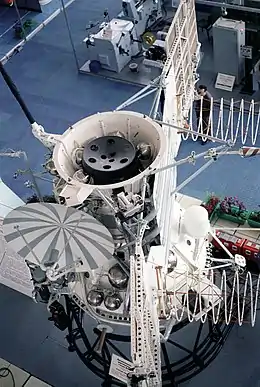5VK
The 5VK planetary probe (short for 5th-generation Venus-Comet probe) is a designation for a common design used for Soviet unmanned probes to comet 1P/Halley and Venus.[1][2] It was an incremental improvement of earlier 4MV probes used for Mars and Venus missions.
 Overhead view of a life-size replica of Vega solar system probe. | |||
| Manufacturer | OKB-1 | ||
|---|---|---|---|
| Country of origin | Soviet Union | ||
| Operator | Soviet Space Program | ||
| |||
Design
The craft was three-axis stabilized[3] and powered by twin large solar panels, weighing 4,920 kg (10,850 lb). They were equipped with a dual bumper shield for dust protection from Halley's comet. Instruments included an antenna dish, cameras, spectrometer, infrared sounder, magnetometers, and plasma probes.[4][3]
See also
References
- "Vega 5VK". www.astronautix.com. Archived from the original on August 19, 2016.
- Erickson, Lance K. (October 2, 2010). Space Flight: History, Technology, and Operations. Rowman & Littlefield. ISBN 9780865874190 – via Google Books.
- "VEGA Mission". arc.iki.rssi.ru.
- "SBN Mission Support: Vega 1". pdssbn.astro.umd.edu.
This article is issued from Wikipedia. The text is licensed under Creative Commons - Attribution - Sharealike. Additional terms may apply for the media files.
.svg.png.webp)